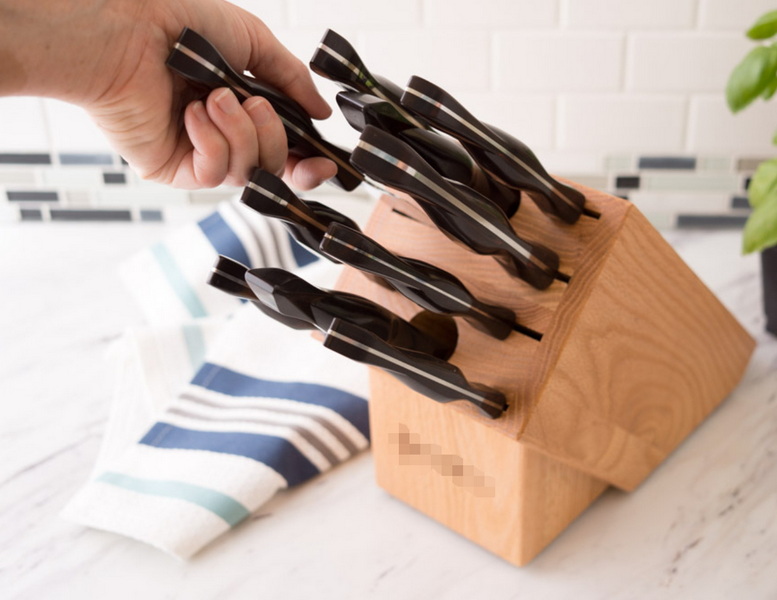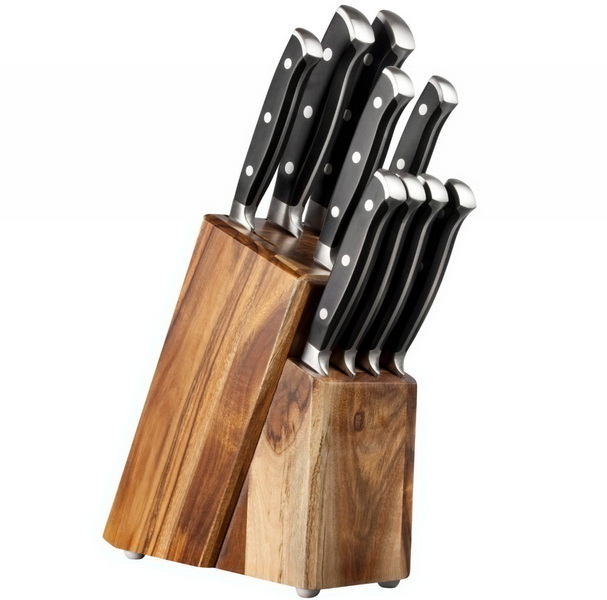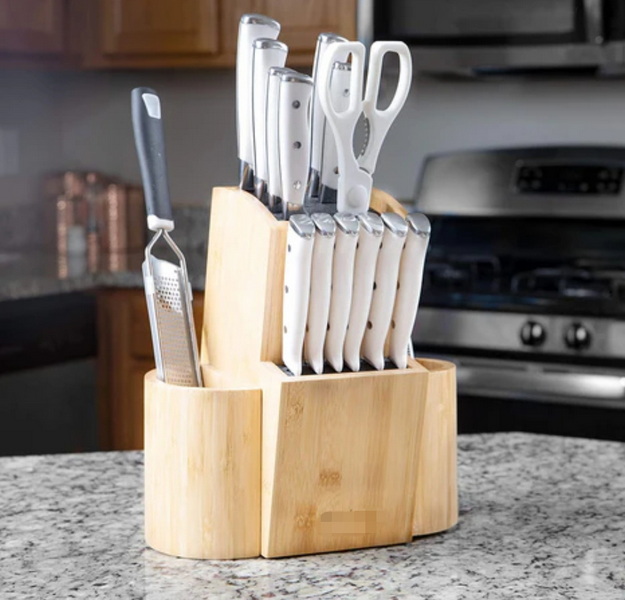- All
- Product Name
- Product Keyword
- Product Model
- Product Summary
- Product Description
- Multi Field Search
Views: 222 Author: Ann Publish Time: 2025-08-24 Origin: Site











Content Menu
● The Role of the Knife Block in Modern Kitchens
● Benefits of Using a Knife Block Safely
● Essential Knife Block Safety Practices
>> 1. Insert Knives with the Blade Facing Down
>> 3. Regular Cleaning and Maintenance
>> 4. Keep Knife Blocks Away from Children
>> 5. Avoid Overstuffing the Knife Block
>> 6. Slot Matching: One Knife, One Space
>> 7. Regularly Sharpen and Inspect Knives
>> 8. Choose Ventilated Knife Blocks
>> 9. Consider Using Knife Guards
>> 10. Correct Placement in the Kitchen
● Hygiene and Food Safety Concerns of Knife Blocks
● Alternative Knife Block Designs
● Professional Kitchen Use of Knife Blocks
● Knife Block Materials and Durability
● Additional Safety Tips for Knife Block Users
● Frequently Asked Questions (FAQ)
>> Q1: How often should I clean my knife block?
>> Q2: Can stainless steel knife blocks develop bacteria like wooden blocks?
>> Q3: Are magnetic knife blocks safe for knife blades?
>> Q4: What is the safest location for a knife block in the kitchen?
>> Q5: When should I replace my knife block?
Keeping your kitchen safe is just as important as keeping it efficient. One of the most common tools in every cooking space is the knife block. While knife blocks are convenient, hygienic, and stylish, many home cooks and even professional chefs overlook the importance of using them properly. If not managed carefully, they can turn into sources of safety hazards, hygiene issues, and even shorten the life of your premium knives.
This comprehensive article will explore knife block safety practices, hygiene maintenance, and organizational strategies every kitchen should follow. Whether you are a home cook, a culinary student, or a restaurant owner, this guide will provide practical steps to keep your kitchen safe and efficient.

A knife block is more than just a storage accessory. It protects your knives' edges, keeps countertops clutter-free, and reduces the chance of accidental cuts from loose tools. For kitchens that use a wide variety of knives—chef's, paring, bread, utility, carving, or cleavers—a well-designed knife block ensures everything has its proper place.
The knife block is not only about convenience—it is also about maintaining knife integrity. Storing knives in random drawers often leads to friction against other utensils, dulling edges much faster.
- Organization: Keeps knives sorted and easy to find.
- Blade Protection: Prevents dulling and bending compared to drawer storage.
- Safety: Reduces risk of accidental cuts when reaching for kitchen tools.
- Efficiency: Saves time during cooking by having knives ready at hand.
- Aesthetics: A visually appealing knife block can enhance the look of your countertop.
But to enjoy these benefits, you must follow proper knife block safety practices.
When placing knives into the block, always ensure the blade faces downward. This prevents accidental hand injuries when reaching for handles and also minimizes damage to knife edges.
One of the most common mistakes is sliding a knife back into the knife block while it is still wet. Trapped moisture not only dulls the blade but also encourages bacterial growth inside the slots. Always dry knives completely before storage.
Maintaining the hygiene of your knife block is crucial. Food particles, crumbs, dust, and moisture often accumulate in the slots.
Steps for cleaning a knife block:
1. Remove all knives carefully.
2. Turn the block upside down and shake loose debris.
3. Use a thin brush or pipe cleaner for inside slots.
4. Wipe with a damp cloth and mild soap solution.
5. Disinfect with diluted vinegar or food-safe sanitizer.
6. Allow the block to air dry completely before inserting knives again.
Safety should always be a priority. A knife block should be placed out of children's reach, ideally on high counters or inside a locked cabinet.
Each slot is designed for a specific blade size and shape. Forcing a knife into the wrong slot can damage both the knife and the block. Overcrowding can also cause knives to rub against one another, dulling blades.
A correctly designed knife block has defined spaces for chef's knives, bread knives, paring knives, utility knives, and scissors. Pairing each knife to its correct slot increases stability and reduces wear.

Sharp, well-maintained knives are safer to use and easier to store. Dull blades require more pressure during use, increasing the likelihood of slipping and injury. Always sharpen knives before storing them in your knife block to prolong both safety and efficiency.
Modern knife block designs often feature ventilation holes or vertical slots that allow airflow inside. Better ventilation means less chance of mold or bacterial buildup.
Knife guards (plastic or silicone sheaths) add an additional layer of protection for knives and slots. They keep the cutting edges intact and reduce splintering inside the wood.
Never place a knife block too close to the sink or stove. Constant steam, splashes, and moisture exposure foster bacterial growth and shorten both knife and block lifespan. A dry, cool section of the countertop is ideal.
A critical but often ignored issue with knife blocks is food safety. Studies have shown that poorly maintained wooden knife blocks can harbor harmful microorganisms. These arise due to closed, damp environments inside the slots.
Best practices to reduce contamination:
- Allow knives to dry for at least 5 minutes before storage.
- Clean and sanitize the knife block monthly.
- Consider UV-sterilizing blocks for professional kitchens.
- Replace old blocks if they develop moldy odors or visible cracks.
While traditional wooden knife blocks remain popular, alternative designs provide additional safety or hygiene benefits:
- Magnetic Knife Blocks: Easy to clean, no hidden slots, visually appealing.
- In-Drawer Knife Blocks: Perfect for small kitchens; keep knives neatly concealed.
- Wall-Mounted Strips: Save countertop space but require extra caution with children.
- Rotating Knife Blocks: Allow easy access to knives from different angles.
In restaurants, hotels, and culinary schools, knife blocks are essential for organization and training. However, commercial environments demand stricter hygiene and safety protocols.
- Knife blocks are deep-cleaned on a schedule.
- Each slot may be labeled for specific knife types.
- Some kitchens prefer modular or stainless knife holders that withstand heavy sanitization.
- Staff undergo training on correct insertion and removal practices.
Different materials impact not just durability but also safety:
- Wooden Knife Blocks: Classic and stylish, but most susceptible to bacterial buildup if not cleaned.
- Bamboo Knife Blocks: Eco-friendly, less porous than hardwood, but still require care.
- Stainless Steel Knife Blocks: Durable, modern look, easier to sanitize.
- Acrylic / Plastic Knife Blocks: Affordable, see-through designs allow visibility, but less durable long term.
Each material has unique pros and cons. The key is maintenance, regardless of type.
- Label handles of knives for quick identification.
- Do not leave knives halfway inserted, always push them into designated slots fully.
- Check stability of the knife block; a wobbling block can cause accidental tipping.
- Do not use damaged blocks; cracks harbor bacteria and compromise structure.
- Train family members or kitchen staff on safe handling practices.
The knife block is more than just a kitchen decoration—it is a safety tool, an organizational aid, and a protector of your most important kitchen assets. But without proper use and regular maintenance, it can turn into a hidden hazard. By following the best practices laid out in this article—drying knives before storage, frequent cleaning, thoughtful placement, and safe handling—you can maximize the lifespan of both your knives and your knife block while keeping your kitchen environment clean and safe.
Whether you're a home cook interested in hygiene, or a professional responsible for staff training, adopting these safety tips will make your kitchen more efficient, organized, and secure.

A: Perform surface cleaning weekly and deep sanitization monthly. In professional kitchens, cleaning may be required more frequently.
A: Stainless steel is less porous, but any block can accumulate bacteria without regular cleaning.
A: Yes, if the magnet is strong but gentle. However, be careful to avoid dragging the knife edge directly across the magnet.
A: On a stable, dry counter away from sinks, dishwashers, and stoves. This minimizes exposure to heat and moisture.
A: Replace the knife block if it develops cracks, foul odors, mold, or compromised slots that no longer hold knives securely.
The Ultimate Professional Knives for Halal Butchery in Middle Eastern Kitchens
Chef Knife Size Guide: Choosing Between 6″, 8″, 10″, And 12″
Custom Knife Handles: How To Design A Chef Knife That Fits Your Hand Perfectly
Chef Knife Surface Treatments Guide: From Polished Migaki To Damascus Patterns
Inside Our Professional Knife Sample Room: Quality You Can See
Universal Knife Block Buying Guide: Modern Acrylic & ABS Knife Holders for Professional Kitchens
Universal Knife Block: The Complete Guide To Modern, Hygienic Knife Storage
The Complete Guide To Red Handle Knife Sets: Style Meets Functionality in The Kitchen
Professional Knives for Halal Butchery And Middle Eastern Cuisine